Click here to print
“The Daughter of Dawn” Will Never Go Dark
posted January 4, 2014
Oklahoma’s “The Daughter of Dawn” is a 2013 addition to the U.S. National Film Registry
n
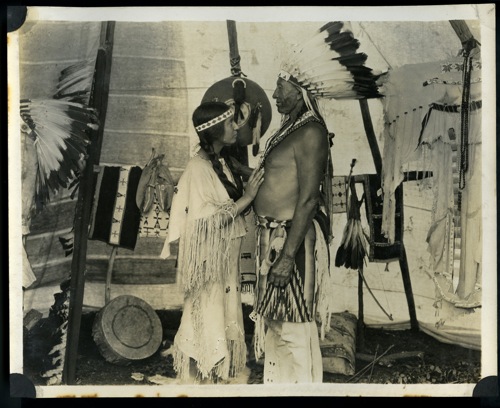
The daughter of the chief discusses her marriage plans with father. Still from “The Daughter of Dawn.” Image: Oklahoma Historical Society/Milestone Films.
In the early days of motions pictures, movies weren’t made for American Native audiences. Even when, in 1920, a feature film was made whose actors were all from the Comanche and Kiowa tribes of Oklahoma, it was made by white Americans for white Americans.
That was The Daughter of Dawn, a love story that ended happily but seemed, soon after its first few screenings, to meet the same tragic end that some 70 percent of silent films did: It appeared to perish from neglect, damage, or deterioration.
After the film was shot in the summer of 1920 and then released in October of that year, it was shown only a few times — in Los Angeles, Kansas City, Tulsa, and a handful of other cities. Then it seemed to have disappeared without trace. And the loss was much lamented among Oklahoma’s film aficionados and archivists in part because the film was one of the first feature-length movies made in the state, and certainly the only one to feature a cast comprised of 300 citizens of the two tribal nations. The Comanche and Kiowa people had at that time lived on reservations for fewer than 50 years, and the actors brought various items and social ways to the set. Among those were their tipis, horses, clothing, and other trappings of what remained of their tribal lives. The film looked back to a time when the tribes had lived on the southern plains of what would haltingly become the state of Oklahoma — the region was fought over by Napoleon’s forces, as well as French, English, and American armies. The film depicted, relatively realistically, a buffalo hunt, intertribal skirmishing, and ceremonial dances that U.S. authorities were doing their best to discourage and suppress. In theory, the actors were breaking the law. “The government was really trying to squash anything to do with the tribes,” Bill Moore, a now-retired film archivist at the Oklahoma History Center told the Oklahoma Gazette in September 2013. “They didn’t want them to dance. They didn’t want them to use their language.”
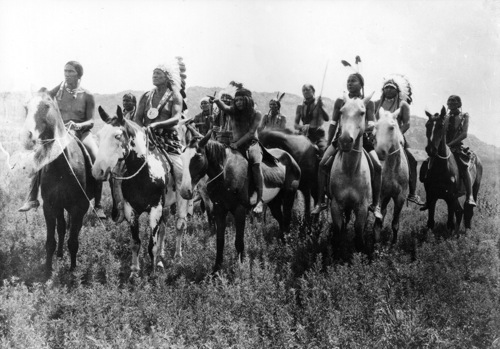
Still from “The Daughter of Dawn.” Image: Oklahoma Historical Society/Milestone Films.
Find the film, and it would present “a glimpse from the past,” he said.
Indeed, in 2007 that Moore received a phone call from Brian Hearn, film curator at the Oklahoma City Museum of Art, who had stunning news. Hearn told Moore that he had been contacted by a private investigator in North Carolina who had come upon the film.
The PI had received reels of film from a client in lieu of other payment. It was the long-lost Daughter of Dawn. Hearn knew its significance, and appealed to Moore to bring it back to Oklahoma. The archivist did, by raising money in and around Lawton, Oklahoma, near where the film was shot in the Wichita Mountains Wildlife Refuge in the state’s southwest, and acquired the film on the Historical Society’s behalf. At $7,000, it was a bargain.
The Society worked with film historians and preservationists to restore the six-reel print to near original condition, says Bob Blackburn, the executive director of the Society. “This film is an American treasure both as an early art form in the history of cinema and as a window into the material culture of Oklahoma’s Kiowa and Comanche tribes.”
On December 18 2013, in recognition of those aspects of the unusual 80-minute silent film, the U.S. Librarian of Congress included The Daughter of Dawn among 25 films that comprise the 2013 intake to the United States National Film Registry. That designation guarantees historically and culturally significant films permanent preservation as key cultural, artistic, and historic achievements in filmmaking. Films entered onto the Registry are preserved either through the Library’s motion-picture preservation program or through collaborations with other archives, motion-picture studios, and independent filmmakers.
The nomination also honors the Oklahoma Historical Society for retrieving the film from the grave. It now holds master copies of the film.
Romance, skirmishing, and plummeting suitors
The plot of The Daughter of Dawn is unremarkable romance, but with some twists. White Eagle (White Parker, son of Quanah Parker, one of the last Comanche chiefs, and an extraordinary figure) longs for Dawn (Esther LeBarre), the daughter of the neighboring Kiowa chief (Hunting Horse). But the chief insists that she also consider Black Wolf (Jack Sankey-doty), who is in love with her, too. The chief’s reasoning is that Black Wolf ha many ponies, so merits consideration. To complicate matters, Red Wing (Wanada Parker, daughter of Quanah Parker) is in love with Black Wolf.
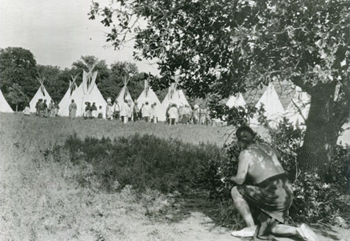
Trouble brewing. Still from “The Daughter of Dawn.” Image: Oklahoma Historical Society/Milestone Films. [Click on image for video clip.]
Thanks to run-ins with studio heads, Myles found himself blackballed by the early 1920s, but was bailed out by an acquaintance: the fascinating Richard E. Banks. He had started up the Texas Film Company in 1916, and lived among the Comanche for 25 years. He asked Myles to direct a film of an “old Comanche legend.”
Due to his respect for Banks, Myles readily headed east from Los Angeles to Lawton, Oklahoma, by train, where Banks and a cameraman took to the film location. He wrote on the cover of his script: “This story has been made possible by R.E. Banks, whose knowledge of the Indian, and of his traditions, was gained during the twenty-five years that he lived with them.”
These details were included in an article in the Fall 1999 issue of the Chronicles of Oklahoma by an Oklahoma history teacher, Leo Kelley. He had access to 36 production photos housed at the Museum of the Western Prairie in Altus, a former trading post turned Oklahoma town. He also consulted the original script of the film housed at the Library of Congress. Unfortunately,” Kelley wrote, “very little knowledge of the actual shoot has been preserved, and even more heartbreaking, the film itself has probably been lost forever.” But with photos and the script, he sought to evoke how the film may have appeared to its few, early audiences. He leavened his tale with the knowledge that when the film first screened in Los Angeles in October 1920, it was hailed as an “original and breath-taking adventure” that had “hardly been duplicated before.”
Kelley noted, too, that Myles had mentioned in an article that he impressed by the participation of the Indian actors, particularly White Parker, son of the legendary Comanche chief Quanah. Myles had written: “Some people in Hollywood had joked that I’d probably loose my scalp…but they would be surprised to know that…the [Indians] spoke better English than they did.”
Myles also noted that the actors were “very shrewd” in negotiating pay and perks. The children of Quanah Parker, in particular, were surprising, because while their father was the son of a Comanche chief, their mother was Cynthia Ann Parker, an English-American woman who had been kidnapped at the age of nine and assimilated into the tribe.
How to woo the daughter of the chief
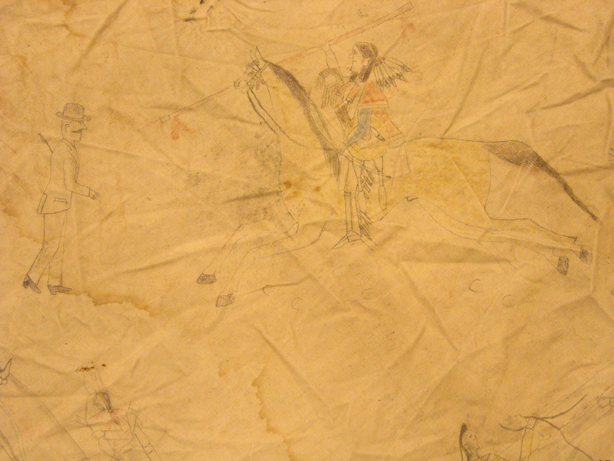
Battle scenes on the tipi used in “The Daughter of Dawn.” Image: Oklahoma History Society.
The action of The Daughter of Dawn centers around the melodramatic love tangle. The chief devises a trial to determine which suitor is more worthy – the white Eagle or the black Wolf. Both might reasonably have opted for celibacy, when the chief announced it: They must jump from a cliff, with survival to decide the ascendant suitor.
In his Chronicles of Oklahoma article, Kelley reports – or perhaps he is surmising — the protagonists’ likely words, unheard though they would be. The chief, he decides, tells the two young men: “Do either of you fail in this you shall no longer be worthy of the name Comanche, and shall be turned out of the tribe to live among the coyotes, if even they will have you.”
One brave plummets to the rocks beneath, while the other halts his fall by grabbing onto branches, en route. Will the chief’s daughter now have a choice between a crippled, perhaps dead hero and a coyote-pack-dwelling chicken?
What inter-tribal strife will the dispute rouse?
More than strife, it turns out: There’s bloodshed and other grief aplenty before the tale is done.
Kelley writes: “Though the motion picture was produced by whites for white audiences, the scenes do provide insight into Comanche and Kiowa customs, lodging, warfare, and dress.”
A first for Oklahoma
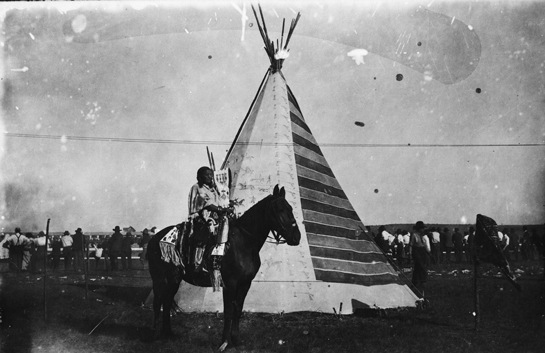
The tipi used in “The Daughter of Dawn” was, like the film, rediscovered and is included in a traveling exhibition. Image: Oklahoma Historical Society.
Not only was The Daughter of Dawn one of Oklahoma’s earliest film dramas, it also is the first narrative movie filmed in Oklahoma to be included in the National Film Registry. Prints and exhibits about it will reside permanently at the Oklahoma Museum of Popular Culture, a new museum that OHS is building in downtown Tulsa. The museum is mounting a traveling exhibition that will include such items as the historically treasured tipi (above) that the Comanche and Kiowa actors brought to the set.
The museum and the Oklahoma Historical Society have joined with Milestone Films, a New Jersey company, to distribute The Daughter of Dawn, beginning this year, 2014; that will entail a DVD/Blue-ray release as well as high-definition screenings at movie theaters and at national and international film festivals. The DVD/Blu-ray versions will include items on, for example, the history of the film, the Indian history and material culture displayed, and the Wichita Mountains. Also included will be a feature about the historical significance of the remarkable tipi seen in the film. Archivists at the Oklahoma City Museum of Art rediscovered it – in their collection.
Accompanying the film in the restoration is original music that the Oklahoma Historical Society commissioned from composer David Yeagley, a member of the Comanche Nation. In 2012, Oklahoma City University’s Symphony Orchestra under the direction of Ben Nilles recorded the music.
Scenes from the film, with music composed by David Yeagley
The opening scenes of the film.
Kiowa Chief calls for buffalo meat to save his hungry people.
White Eagle tells the Chief that he has seen the buffalo herd.
The Thanksgiving Dance for the buffalo herd.
— from press releases and research, by Peter Monaghan
Printed from Moving Image Archive News: https://www.movingimagearchivenews.org
URL to article: https://www.movingimagearchivenews.org/the-daughter-of-dawn-will-now-never-go-dark/
Click here to print